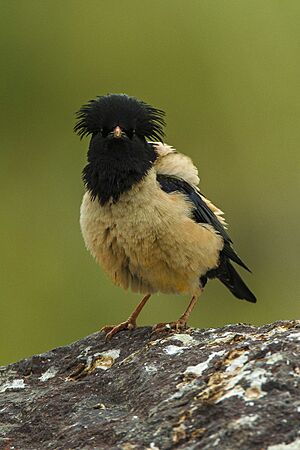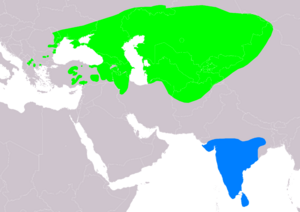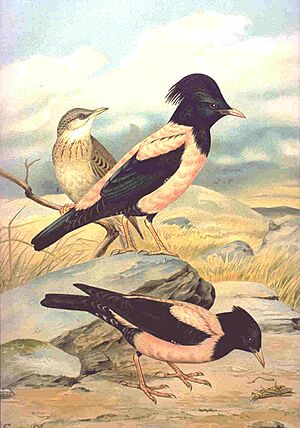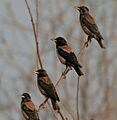Rosy starling facts for kids
Quick facts for kids Rosy starling |
|
|---|---|
 |
|
| Male in Almaty, Kazakhstan | |
| Conservation status | |
| Scientific classification | |
 |
|
| Range of P. roseus (Compiled by: BirdLife International and Handbook of the Birds of the World (2016) 2007, IUCN 2020.1) Breeding Non-breeding | |
| Synonyms | |
|
The rosy starling (Pastor roseus) is a type of bird in the starling family. People also call it the rose-coloured starling or rose-coloured pastor. This bird is known for its pretty pink body.
Scientists recently placed the rosy starling in its own special group, called Pastor. Before this, it was grouped with other starlings in the Sturnus group.
Contents
About the Rosy Starling
How Scientists Name Birds
The rosy starling was first officially described in 1758. A Swedish scientist named Carl Linnaeus gave it the scientific name Turdus roseus. He put it with the thrushes at that time.
Later, in 1815, a Dutch scientist named Coenraad Jacob Temminck created the group Pastor just for this bird. The rosy starling is the only species in this group.
The name Pastor comes from a Latin word meaning "shepherd." The word roseus is Latin for "rose-coloured," which describes the bird's pink feathers.
What Rosy Starlings Look Like
Adult rosy starlings are easy to spot. They have a pink body, light orange legs, and a light orange beak. Their head, wings, and tail are shiny black.
Male birds in the breeding season have long feathers on their heads. These feathers form a wispy crest. This crest looks bigger when the bird is excited. In winter, the crest is shorter. The black feathers also look duller.
Female rosy starlings have a shorter crest. Their pink and black colours are not as sharply separated as in males.
Young rosy starlings look different from adult birds. They have paler feathers and a short yellow beak. You can tell them apart from young common starlings because they are much paler. As they grow, young birds get feathers that look a bit like adults. However, they do not have a crest yet. Males take almost two years to get their full adult feathers. Females get theirs in about one year.
Where Rosy Starlings Live
Rosy starlings breed in dry, open areas. These areas include steppes, semi-deserts, and deserts. You can find them in Central Asia and Southeast Europe. Their breeding range stretches from Mongolia to countries like Kazakhstan, Ukraine, and Armenia. They also breed in northern Afghanistan and Iran.
These birds are strong migrants. This means they travel long distances. They spend their winters in India and other warm parts of Asia. In winter, you might see more rosy starlings in India than local starlings.
Rosy starlings like open farmland. Sometimes, when there are many grasshoppers, these birds travel far from their usual homes. They have even been seen in places like France and the United Kingdom.
Rosy Starling Life and Habits
How They Live Together
Rosy starlings are very social birds. They often live in large, noisy groups called flocks. These big flocks can sometimes be a problem for farmers. This is because the birds love to eat fruits from crops and orchards.
However, rosy starlings are also very helpful to farmers. They eat many harmful insects, like locusts and grasshoppers. This helps to control the number of these pests. The birds breed in large groups in a very short season. They time their breeding to happen when grasshoppers are most plentiful, usually in May and June.
Reproduction and Breeding
Rosy starlings breed in colonies, meaning many pairs nest close together. Like other starlings, they are very social. They form large flocks in winter. They eat many different things, but they especially like insects.
Their song is a mix of squeaks and rattles. They often tremble their wings when they sing.
In Xinjiang, China, farmers used to use chemicals to kill locusts. This was expensive and bad for the environment. In the 1980s, experts found that rosy starlings could help. The starlings fly to Xinjiang farms and eat the locusts. So, experts started building special nests to attract the starlings. This worked so well that there were not enough locusts for all the baby birds to eat! Many young birds died because of hunger. By the 2000s, many farms in Xinjiang used much less chemical spray.
What Rosy Starlings Eat
Rosy starlings mainly eat fruits, berries, flower nectar, grains, and insects.
Here are some of the foods they like:
- Fruits and berries: Figs, Lantana berries, grapes, mulberries, dates, and chillies.
- Flower nectar: From trees like Salmalia, Bombax, and Erythrina.
- Grains: Such as jowar and bajra.
- Insects: Mostly locusts and grasshoppers. They also eat different kinds of beetles.
Images for kids










